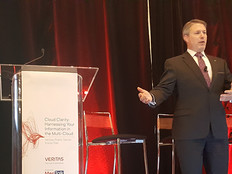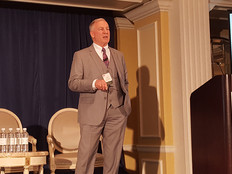GITEC 2018: Cloud Helps Feds Focus on Their Missions, Save Money
Federal agencies should not be in the business of running data centers. That’s the unequivocal opinion of the Agriculture Department’s Chad Sheridan.
Sheridan, speaking on a panel about cloud and shared services at GITEC Summit 2018 in Annapolis, Md., on April 23, said that agencies that run data centers essentially become utility providers to ensure that the data center stays up and running — and that work only gets noticed if the data center’s operations are interrupted.
Sounding themes he has been expounding on in the federal IT community, Sheridan said, “If I am spending all my time making sure something works, then I’m not spending my time building services for farmers and ranchers around this country,” said Sheridan, the CIO of USDA’s Risk Management Agency (though Sheridan noted that with the agency’s reorganization, he is now an IT director for USDA’s farm production and conservation mission area).
Sheridan and other panelists noted that the cloud allows agencies to gain efficiencies, cut costs and spend more time focused on their core missions and less on “utility-value” services.
SIGN UP: Get more news from the FedTech newsletter in your inbox every two weeks!
How the Cloud Helps Agencies Gain Efficiencies
Edward Davis, deputy CIO of the Corporation for National and Community Service (which is the parent agency for AmeriCorps), said on the panel that the agency worked with its vendor partners and determined that it was spending too much on core IT services.
So, the CNCS decided to partner with Microsoft for its Azure cloud and Office 365 suite to gain efficiencies by adopting a Software as a Service model. “It began with our contractors,” Davis said. He advised agencies to write clauses into contracts that encourage vendor partners to help them innovate and stay at the leading edge of technology. “If you’re not doing that, you’re failing,” he said.
With the cloud, agencies always need to look for opportunities to save money. Agencies rely on their vendor partners to get information on what options are available and what the cost savings might look like, Davis said.
The CNCS has a data center of its own, but Davis noted that after he joined the CNCS in November 2014, agency employees reminisced about when the data center wasn’t available for two to three days. “‘Is that real?’” Davis said he asked. “It was. It was very real. People talked about it.”
By engaging with “mature” cloud service providers, the agency was able to “get the cost savings and the downtimes went away,” Davis said.
Cloud-based solutions can not only help agencies save costs by helping them shutter data centers and consume software in SaaS models. The cloud can also help provide shared services for agencies.
Robert Wuhrman, enterprise solutions architect at the Office of Government-wide Policy in the General Services Administration, noted that there are 118 time and attendance systems that agencies “have to maintain, update and customize to the extent they feel they need to.” Agencies also have their own unique procurement, human resources and other systems.
“What is the opportunity to work with industry for commercial SaaS offerings in a cloud environment” that can be applied to those systems? Wuhrman asked.
In December, the GSA issued a draft request for quotation for a SaaS solution that includes functionality for payroll and work schedule and leave management, Wuhrman noted. The RFQ says that moving to a SaaS model will allow the government to leverage its scale and “enable agencies to focus resources (human and fiscal) on core mission priorities, which will reduce costs, significantly improve security posture, increase user experience and service, and better manage budgets.”
The government anticipates streamlining employee time reporting and payroll processing using standard application program interfaces and data schemas to support data exchanges between legacy human resources and financial management systems and the SaaS solutions, the RFQ says.
For our all of our articles from the conference, check out FedTech’s coverage of the GITEC Summit 2018 here.








